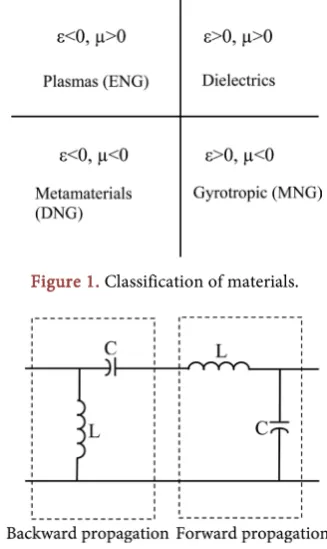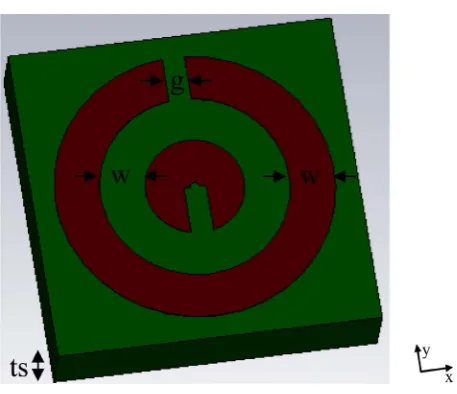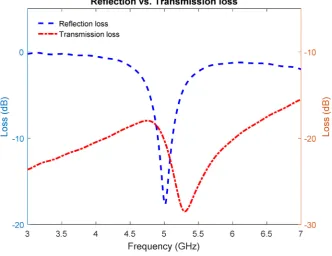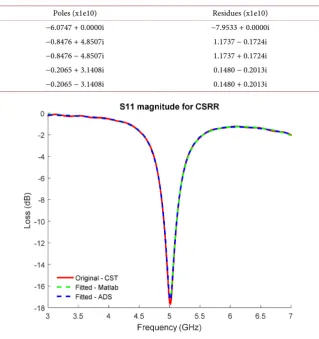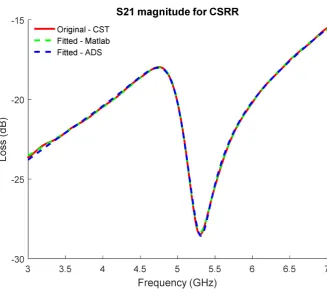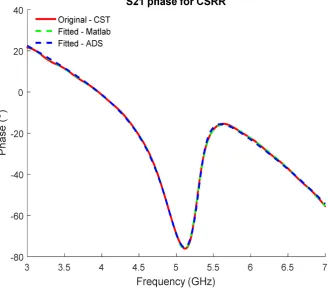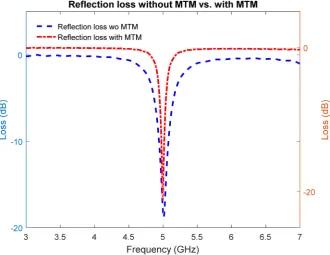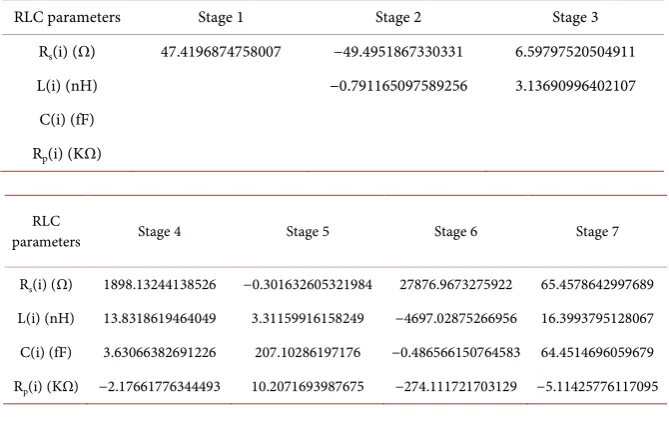ISSN Online: 2329-8413 ISSN Print: 2329-8421
DOI: 10.4236/ojapr.2017.53011 Sep. 27, 2017 132 Open Journal of Antennas and Propagation
Patch Antenna Miniaturization Using CSRR
Varindra Kumar
Department of Engineering, University of Cambridge, Cambridge, UK
Abstract
A novel metamaterial structure has been proposed for Electromagnetic Com-patibility (EMC) applications. A patch antenna with dimension of 18 mm × 13.9 mm and resonating at 5 GHz has been designed and the effect of Double Negative (DNG) metamaterial loading for the patch size reduction as well as a lowering in resonance frequency for the fixed size patch antenna has been proposed. A size reduction of 72.5% in the patch antenna has been obtained with the loading of this metamaterial structure and the effect of loading the metamaterial shows that without reducing the size, the patch antenna can work at 3.7 GHz resonance, providing a lowering in resonance frequency by 26%. The metamaterial structure consists of two concentric loops with an outer radius of 3.1 mm. The width of the ring is 1.0 mm and the split is 0.5 mm and has been designed over a 1.57 mm thick Fr4 substrate. The bending effect of the patch antenna with and without metamaterial loading and its comparison with the planar patch antenna has been also shown here. The metamaterial structure has shown its resonance at 5 GHz and its permittivity and permeability behavior over the desired frequency range has been plotted. The simulation of traditional patch antenna and patch antenna over metama-terial has been compared for its return loss, VSWR, gain and efficiency. Final-ly, a spice circuit for the S parameter of the metamaterial, patch antenna and patch antenna loaded with metamaterial has been obtained using Matlab and ADS for its equivalence to 3D field solver and its comparison has been plotted for its verification.
Keywords
DNG Metamaterial, CSRR, 5 GHz, Patch, Spice, Planar, Bend
1. Introduction
During the last few years, there has been a significant increase in portable elec-tronics devices and these are often interconnected through wireless media within How to cite this paper: Kumar, V. (2017)
Patch Antenna Miniaturization Using CSRR. Open Journal of Antennas and Propagation, 5, 132-150.
https://doi.org/10.4236/ojapr.2017.53011
Received: August 28, 2017 Accepted: September 24, 2017 Published: September 27, 2017
Copyright © 2017 by author and Scientific Research Publishing Inc. This work is licensed under the Creative Commons Attribution International License (CC BY 4.0).
http://creativecommons.org/licenses/by/4.0/
DOI: 10.4236/ojapr.2017.53011 134 Open Journal of Antennas and Propagation metamaterial in the patch size reduction, Section 4 for patch antenna and its bend effect, Section 5 for patch antenna and resonance frequency shift with the loading of metamaterial structure and finally Section 6 for simulation results and its comparison. The spice circuit provides a convenient mechanism to build and verify any electrical circuit, however, the antenna design in the present 3D space cannot be integrated within a spice tool. The Spice circuit for the CSRR meta-material structure, antenna when loaded with metameta-material and antenna without loading metamaterial has been extracted and the method to extract the spice circuit parameters has been described in their respective sub-sections.
2. CSRR Design
[image:3.595.290.454.435.710.2]Any electromagnetic material can be identified by its dielectric permittivity “ε” and magnetic permeability “µ” and it belongs to one of the group defined in
Figure 1. A metamaterial structure provides unique property for its electro-magnetic response with its negative dielectric permittivity “ε” and negative magnetic permeability “µ”. The metamaterial structure such as SRR was pro-posed by Pendry et al. [2] for its Left Hand Material (LHM) studies, this led to the beginning in the design and demonstration for CSRR based electromagnetic applications [11] [12] [13] [14]. The structure is formed by two concentric rings with splits at its opposite at the inner and outer rings.
A LHM metamaterial also known as NRI metamaterial structure supports both forward energy flow and backward wave propagation at the same time, providing a phase shift of 180˚ in phase (vp) and group velocity (vg) [3]. The NRI
Figure 1. Classification of materials.
DOI: 10.4236/ojapr.2017.53011 135 Open Journal of Antennas and Propagation Figure 3. CSRR structure.
structure can be represented by a Left Handed (LH) material however the para-sitic effect of the media supports the ordinary Right handed (RH) wave propaga-tion at higher frequency. An equivalent circuit of the NRI material as a combi-nation of LH and RH metamaterial, can be represented using an equivalent cir-cuit of Figure 2 where one portion of the circuit represents the backward prop-agation of the wave (as LHM) while another portion represents a forward wave propagation (as RHM). Concentric rings as shown in Figure 3 has been de-signed over Fr4 substrate (dielectric constant of 4.4 and tangent loss of 0.02) with dimension of 7.2 mm × 7.2 mm × 1.57 mm. Outer as well as inner ring has been designed with a copper thickness “ts” of 0.017 mm, the outer ring has ra-dius “R” of 3.1 mm while the width “w” of the ring is 1.0 mm and split gap “g” is 0.5 mm. Full field solver tool CST microwave studio is used to design the model and get the simulation results. Using the individual ring dimension and taking an average of the inductance with the sum of capacitance across two rings, an approximate resonance frequency is obtained for the concentric rings with the analytical formula defined using (1) and (2) [15]. Although the analytical calcu-lation using (1 - 5) results in 4.8775 GHz resonant frequency while the full field solver tool provides the resonance frequency of 5 GHz, the difference can be at-tributed to the simplicity in the formula representation by using lumped ele-ments.
(
)
(
)
0
log 8*
width
0.5
ringL
=
µ
∗ ∗
R
R ts
+
−
(1)
(
)
(
)
(
)
0
2* *
width
*log 4*
surfC
=
ε
ts
+
pi
R gap
(2)(
)
(
)
0* *width 0* width
gap
C =
ε
ts gap+ε
ts gap+ + (3)ring surf gap
C =C +C
(4)
(
)
(
(
)
)
(
12 12)
1 2* *
*
*
1 / 2
res ring ring r
f
=
pi L
C
sqrt
ε
+
(5)wave-DOI: 10.4236/ojapr.2017.53011 136 Open Journal of Antennas and Propagation guide with PEC and PMC conditions applied on its orthogonal wall while the structure is excited along x- direction using an electric field. The return and
[image:5.595.205.544.153.726.2]transmission loss of the CSRR structure has been plotted and shown in Figure 4. The relative permittivity and permeability parameters of the unit cell has also been calculated and shown in Figure 5 and Figure 6. As seen from Figure 5 and
Figure 4. Return vs. Transmission loss.
[image:5.595.208.541.160.416.2]DOI: 10.4236/ojapr.2017.53011 137 Open Journal of Antennas and Propagation Figure 6. Permeability plot.
Figure 7. Spice circuit for CSRR.
Figure 6, these parameters are negative within its frequency band, hence the de-signed structure can be classified as Double Negative (DNG) metamaterial.
The spice circuit provides a method to electrically interface an electronic structure and provide time/frequency response without the need of costly field solver tools. An equivalent spice circuit element for the CSRR can be obtained using series RLC network by segmenting the ring in unit cells, it has been shown in Figure 7 [16]. However the split of the individual ring can be defined by the split capacitance. Since there are two concentric rings, there are capacitive and inductive coupling elements between these two rings as well. Here Ro, Lo and Ri,
DOI: 10.4236/ojapr.2017.53011 138 Open Journal of Antennas and Propagation between two rings is defined as Coi. The Matlab based rational fit algorithm [17]
as defined using (6) provides an efficient method to extract poles and residues within reasonable iterations to approximately represent the S parameters. Here Pi and Zi are complex poles and residues with an order “N” while constants d
and s are constant terms and e is the proportionality term. The function can be realized by means of RLC elements with a rational approximation of admittance. After deriving s-parameters, ABCD parameters can be found out and can be converted into admittance form.
( )
1 N i i i ZH S d se
S P = = + + −
∑
(6)The derived rational function is correlated with its admittance and RLC values can be calculated. The equivalent spice circuit for the CSRR has been shown in
[image:7.595.215.535.371.711.2]Figure 7 while Table 1 shows the extracted poles and residues obtained from ra-tional function using Matlab. ADS tool has been also used to extract the spice parameters using its inherent spice extraction mechanism when the passivity is enforced. Due to complexity in the representation of RLC stages (ADS tool ex-tracts the spice circuit with more than ten numbers of RLC stage), only S para-meter plot has been shown in Figures 8-11. The exact spice circuit mechanism
Table 1. Poles and Residues for CSRR.
Poles (x1e10) Residues (x1e10)
−6.0747 + 0.0000i −7.9533 + 0.0000i
−0.8476 + 4.8507i 1.1737 − 0.1724i
−0.8476 − 4.8507i 1.1737 + 0.1724i
−0.2065 + 3.1408i 0.1480 − 0.2013i
−0.2065 − 3.1408i 0.1480 + 0.2013i
DOI: 10.4236/ojapr.2017.53011 139 Open Journal of Antennas and Propagation Figure 9. S11 original and fitted phase.
DOI: 10.4236/ojapr.2017.53011 140 Open Journal of Antennas and Propagation Figure 11. S21 original and fitted phase.
remains similar to the presentation in Figure 7. In the subsequent subsections (3.1 and 3.2), the exact mechanism to extract spice circuit has been described.
3. Patch Antenna Planar Design
DOI: 10.4236/ojapr.2017.53011 141 Open Journal of Antennas and Propagation Figure 12. Patch antenna without CSRR.
Figure 13. Patch antenna with CSRR.
Figure 14. Reflection loss for planar patch with and without CSRR loading.
3.1. Equivalent Spice Circuit for Patch without CSRR
An equivalent spice circuit parameters for the patch antenna without CSRR has been derived using Matlab and ADS and its original and fitted response for the magnitude and phase of the S11 parameter has been plotted in Figure 15 and
[image:10.595.209.540.348.603.2]DOI: 10.4236/ojapr.2017.53011 142 Open Journal of Antennas and Propagation Figure 15. S11 original and fitted magnitude.
[image:11.595.212.540.407.689.2]DOI: 10.4236/ojapr.2017.53011 143 Open Journal of Antennas and Propagation Table 2. Poles and Residues for patch without CSRR.
Poles (x1e10) Residues (x1e10)
−1.8983 + 0.0000i −8.2731 + 0.0000i
−0.7258 + 4.4661i 1.1168 + 1.4162i
−0.7258 − 4.4661i 1.1168 − 1.4162i
−1.5079 + 2.8265i 1.8174 − 5.9986i
−1.5079 − 2.8265i 1.8174 + 5.9986i
−0.1337 + 3.1447i 0.0646 + 0.1826i
−0.1337 − 3.1447i 0.0646 − 0.1826i
[image:12.595.206.541.514.727.2]Figure 17. Spice circuit for patch antenna without CSRR.
Table 3. RLC parameters for the spice circuit.
RLC parameters Stage 1 Stage 2 Stage 3
Rs(i) (Ω) 47.4196874758007 −49.4951867330331 6.59797520504911
L(i) (nH) −0.791165097589256 3.13690996402107
C(i) (fF) Rp(i) (KΩ)
RLC
parameters Stage 4 Stage 5 Stage 6 Stage 7
Rs(i) (Ω) 1898.13244138526 −0.301632605321984 27876.9673275922 65.4578642997689
DOI: 10.4236/ojapr.2017.53011 144 Open Journal of Antennas and Propagation The poles and residues derived using a rational function from Matlab with the data of S11 parameter from CST tool has been shown in Table 2. The poles and residues have been equated to RLC parameters after the S-parameter conversion to ABCD parameters and equating the transfer function to the admittance. Si-milarly ADS tool has been used to extract the spice parameters while passivity is enforced. The equivalent spice circuit has been shown in Figure 17 while the in-dividual RLC value has been shown in Table 3. The magnitude and phase plot in
Figure 15 and Figure 16 show that fitted parameters provide the same response of the spice circuit to its field solver tool response, thus the spice circuit can be used for its equivalence.
3.2. Equivalent Spice circuit for Patch with CSRR
Similarly the original and fitted plot comparison for the magnitude and phase of the S11 parameter for the patch antenna loaded with CSRR has been shown in
Figure 18 and Figure 19. The fitted plot has been obtained after deriving the RLC parameters of the equivalent spice circuit. The poles and residues derived from a rational function using Matlab has been shown in Table 4.
Figure 20 shows the obtained equivalent spice circuit using ADS tool and the RLC values have been shown in Table 5.
DOI: 10.4236/ojapr.2017.53011 145 Open Journal of Antennas and Propagation Figure 19. S11 original and fitted phase.
[image:14.595.62.539.322.547.2]Figure 20. Spice circuit for patch antenna with CSRR.
Table 4. Poles and Residues for patch with CSRR.
Poles (x1e10) Residues (x1e10)
−1.5660 + 4.2981i 1.5002 − 2.7614i
−1.5660 − 4.2981i 1.5002 + 2.7614i
−0.0586 + 3.1388i −0.0534 − 0.0429i
−0.0586 − 3.1388i −0.0534 + 0.0429i
−1.2630 + 1.4337i −2.7321 − 0.6150i
[image:14.595.132.473.601.723.2]DOI: 10.4236/ojapr.2017.53011 146 Open Journal of Antennas and Propagation Table 5. RLC parameters for Spice circuit.
Stage 1 Stage 2 Stage 3
Rs(i) (Ω) 50 −60.9194134324259 41.8363527812994
L(i) (nH) −0.511830216374149 1.52315549511506
C(i) (pF) 0.149219979459191
Rp(i) (KΩ) −0.312687492847095
Stage 4 Stage 5
Rs(i) (Ω) 0.542995516359006 21.2973424540247
L(i) (nH) 2.07841688542428 71.1998803684241
C(i) (pF) 3.12416821215986 0.014152013972141
Rp(i) (KΩ) 6.74554026316824 290.922619952124
4. Patch Antenna Bend Design
[image:15.595.272.478.391.534.2]Patch antenna with and without CSRR loading has been bent with a radius of 20 mm and 40 mm to show the effect of bending. The bend structures have been shown in Figure 21 and Figure 22, while the comparison of the return loss has been plotted in Figure 23.
Figure 21. Bend patch configuration.
[image:15.595.284.464.568.700.2]DOI: 10.4236/ojapr.2017.53011 147 Open Journal of Antennas and Propagation Figure 23. Reflection loss for bend patch without and with CSRR loading.
5. CSRR Loading Effect on Resonance Frequency for Patch
Antenna
The patch configuration as defined in Section 3 has been used for the CSRR loading effect over its resonance frequency. Here the patch element has dimen-sion of 13.9 mm × 18 mm × 0.017 mm with its inset feed of 13.05 mm × 2.8 mm × 0.017 mm and inset gap of 0.5 mm. This patch element has been laid over 30 mm × 30 mm × 1.57 mm Fr4 substrate with its relative permittivity 4.4 and tan-gent loss of 0.02 while the ground layer has been designed using copper conduc-tor with its dimension of 30 mm × 30 mm × 0.017 mm. Figure 12 shows the patch configuration without CSRR loading while Figure 24 (Top view) and Fig-ure 25 (Bottom view) show the same size patch configuration with CSRR load-ing. The CSRR loading as shown in Figure 26 provides resonance frequency shift where the original patch resonates at 5 GHz while the periodic CSRR array loaded patch resonates at 3.7 GHz.
[image:16.595.290.459.577.703.2]DOI: 10.4236/ojapr.2017.53011 148 Open Journal of Antennas and Propagation Figure 25. Patch antenna with CSRR (Bottom side).
Figure 26. Reflection loss for patch with and without CSRR loading.
6. Simulation Results
Table 6 shows the comparison of antenna parameters when patch is not loaded with CSRR and when patch is loaded with CSRR. The parameter for the bend configuration of these elements has also been shown here. The bending of the patch antenna shows a shift in resonance frequency with an increase in efficien-cy and gain. As shown here, although the CSRR loading provides an effective mechanism for miniaturization (72.5% patch size reduction) in patch element, it decreases the gain while providing excellent radiation efficiency.
[image:17.595.208.541.238.503.2]DOI: 10.4236/ojapr.2017.53011 149 Open Journal of Antennas and Propagation Table 6. Patch antenna parameters (with and without CSRR loading).
Patch Freq (fo)
in GHz Bandwidth (MHz) S11 (dB) VSWR Gain (dB) width (˚) Angular
Radiation Efficiency
(%)
Without CSRR
Planar 5.0 136.4 -18.8 1.26 5.16 46.8 87.22
Bend 5.064 135 -12.23 1.65 6.11 48.1 98.30
With CSRR
Planar 5.0 61.8 -20.72 1.20 2.11 82.2 85.10
Bend 4.892 39.1 -18.67 1.26 2.96 80.9 94.16
Table 7. Patch antenna parameters (with and without CSRR loading on same size patch).
Patch Freq (fo)
in GHz Bandwidth (MHz) S11 (dB) VSWR Gain (dB) width (˚) Angular
Radiation Efficiency
(%)
Without
CSRR Planar 5.0 136.4 -18.8 1.26 5.16 46.8 87.22
With
CSRR Planar 3.7 118.9 -12.97 1.58 3.77 50.4 93.15
7. Conclusion
The paper provides a simple mechanism to miniaturize the patch antenna with the CSRR loading for its fixed resonance and show the effect of CSRR loading in the resonance frequency for the original patch size. The design has shown that the loading of CSRR reduces the patch size by 72.5% while loading the CSRR for the same size patch lowers the resonant frequency by 26%. Although the full field solver tool provides a circuit response within its 3D environment, the si-mulation is slow and resource consuming. A spice circuit for these circuits can be an alternative for its use in any spice circuit simulation tool. Hence, an equiv-alent spice circuit and RLGC parameters for the CSRR, patch antenna with and without CSRR loading have been obtained for its inclusion in electrical circuit.
Acknowledgements
The author would like to acknowledge the CSIC at Department of Engineering, University of Cambridge for providing the necessary support and funding for the project. This project was completed as part of the supervision to UROP projects.
References
[1] Pozar, D.M. and Schaubert, D.H. (1995) Microstrip Antennas. John Wiley & Sons Ltd., Hoboken.https://doi.org/10.1109/9780470545270
[2] Pendry, J.B., Holden, A.J., Robbins, D.J. and Stewart, W.J. (1998) Low-Frequency Plasmons in Thin Wire Structures. Journal of Physics Condensed Matter, 10, 4785-4809.https://doi.org/10.1088/0953-8984/10/22/007
[image:18.595.208.539.237.336.2]DOI: 10.4236/ojapr.2017.53011 150 Open Journal of Antennas and Propagation Negative Values of ε and μ. Soviet Physics Uspekhi, 10, 509-514.
https://doi.org/10.1070/PU1968v010n04ABEH003699
[4] Dong, Y., Toyao, H. and Itoh, T. (2012) Design and Characterization of Miniatu-rized Patch Antennas Loaded with Complementary Split-Ring Resonators. IEEE transactions on Antennas and Propagation, 60, 772-785.
https://doi.org/10.1109/TAP.2011.2173120
[5] Erentok, A. and Ziolkowski, R.W. (2008) Metamaterial-Inspired Efficient Electri-cally Small Antennas. IEEE Transactions on Antennas and Propagation, 56, 691-707.https://doi.org/10.1109/TAP.2008.916949
[6] Ziolkowski, R.W., Jin, P. and Lin, C.C. (2011) Metamaterial-Inspired Engineering. IEEE Proceedings of Antennas, 99, 1720-1731.
https://doi.org/10.1109/JPROC.2010.2091610
[7] Garg, R., Bhartia, P., Bahl, I. and Ittipiboon, A. (2001) Microstrip Antenna Design Handbook. Artech House, Boston.
[8] Pendry, J.B., Holden, A.J., Robbins, D.J. and Stewart, W.J. (1999) Magnetism from Conductors and Enhanced Nonlinear Phenomena. IEEE Transactions on Micro-wave Theory and Techniques, 47, 2075-2084.https://doi.org/10.1109/22.798002
[9] Smith, D.R. and Kroll, N. (2000) Negative Refractive Index in Left-Handed Mate-rials. Physical Review Letters, 85, 2933-2936.
https://doi.org/10.1103/PhysRevLett.85.2933
[10] Shelby, A. Smith, D.R. and Schultz, S. (2001) Experimental Verification of a Nega-tive Index of Refraction. Science, 292, 77-79.
https://doi.org/10.1126/science.1058847
[11] Smith, D.R., Padilla, W.J., Vier, D.C., Nemat-Nasser, S.C. and Schultz, S. (2000) Composite Medium with Simultaneously Negative Permeability and Permittivity. Physical Review Letters, 84, 4184-4187.
https://doi.org/10.1103/PhysRevLett.84.4184
[12] Ramzan, M. and Topalli, K. (2015) A Miniaturized Patch Antenna by Using a CSRR Loading Plane. International Journal of Antennas and Propagation, 1-9.
https://doi.org/10.1155/2015/495629
[13] Umadevi, K.S., Chakyar, S.P., Simon, S.K., Andrews, J. and Joseph, V.P. (2017) Split Ring Resonators Made of Conducting Wires for Performance Enhancement. Euro-physics Letters, 118, 24002.https://doi.org/10.1209/0295-5075/118/24002
[14] Castro, P.J., Barroso, J.J., Neto, J.P.L., Tomaz, A. and Hasar, U.C. (2016) Experi-mental Study of Transmission and Reflection Characteristics of a Gradient Array of Metamaterial Split-Ring Resonators. Journal of Microwaves, Optoelectronics and Electromagnetic Applications, 15, 380-389.
https://doi.org/10.1590/2179-10742016v15i4658
[15] Li, D., Yu, J., Zhou, W., Ji, B., Song, B. and Guo, X. (2015) An Analytical Model for Resonant Frequency of the Split Ring Resonators. 8th Europe, China Millimeter Waves and THz Technology Workshop, Cardiff, 14-15 September 2015, 1-3. https://doi.org/10.1109/UCMMT.2015.7460632
[16] Schuette, D., Irfanullah, I., Nariyal, S., Khattak, S. and Braaten, B.D. (2016) Strong Coupling (Crosstalk) between Printed Microstrip and Complementary Split Ring Resonator (CSRR) Loaded Transmission Lines in Multilayer Printed Circuit Boards (PCB). IEEE International Conference on Electro Information Technology (EIT), Grand Forks, 196-199. https://doi.org/10.1109/EIT.2016.7535239
Submit or recommend next manuscript to SCIRP and we will provide best service for you:
Accepting pre-submission inquiries through Email, Facebook, LinkedIn, Twitter, etc. A wide selection of journals (inclusive of 9 subjects, more than 200 journals)
Providing 24-hour high-quality service User-friendly online submission system Fair and swift peer-review system
Efficient typesetting and proofreading procedure
Display of the result of downloads and visits, as well as the number of cited articles Maximum dissemination of your research work
